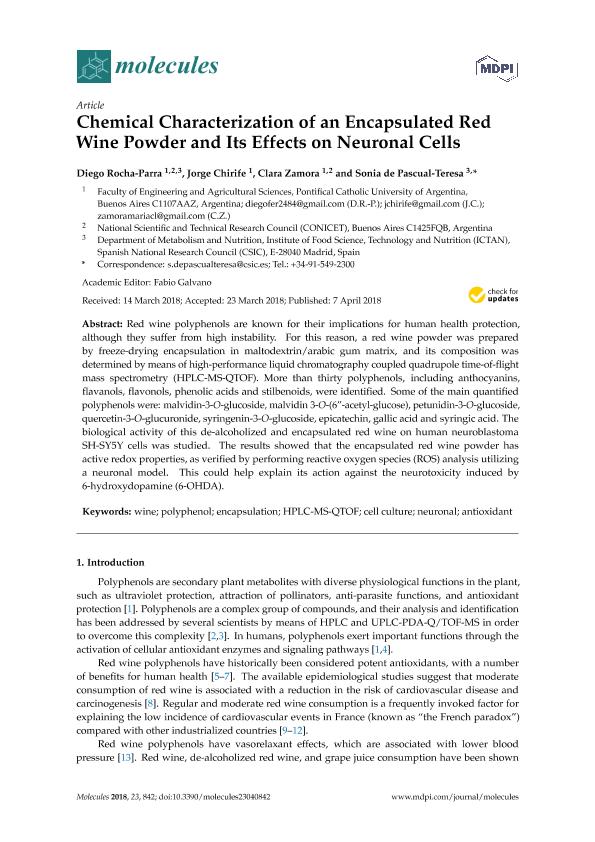Mostrar el registro sencillo del ítem
dc.contributor.author
Rocha Parra, Diego Fernando

dc.contributor.author
Chirife, Jorge

dc.contributor.author
Zamora, María Clara

dc.contributor.author
de Pascual Teresa, Sonia
dc.date.available
2020-02-07T18:06:34Z
dc.date.issued
2018-04
dc.identifier.citation
Rocha Parra, Diego Fernando; Chirife, Jorge; Zamora, María Clara; de Pascual Teresa, Sonia; Chemical characterization of an encapsulated red wine powder and its effects on neuronal cells; Molecular Diversity Preservation International; Molecules; 23; 4; 4-2018; 1-12
dc.identifier.issn
1420-3049
dc.identifier.uri
http://hdl.handle.net/11336/96874
dc.description.abstract
Red wine polyphenols are known for their implications for human health protection, although they suffer from high instability. For this reason, a red wine powder was prepared by freeze-drying encapsulation in maltodextrin/arabic gum matrix, and its composition was determined by means of high-performance liquid chromatography coupled quadrupole time-of-flight mass spectrometry (HPLC-MS-QTOF). More than thirty polyphenols, including anthocyanins, flavanols, flavonols, phenolic acids and stilbenoids, were identified. Some of the main quantified polyphenols were: malvidin-3-O-glucoside, malvidin 3-O-(6”-acetyl-glucose), petunidin-3-O-glucoside, quercetin-3-O-glucuronide, syringenin-3-O-glucoside, epicatechin, gallic acid and syringic acid. The biological activity of this de-alcoholized and encapsulated red wine on human neuroblastoma SH-SY5Y cells was studied. The results showed that the encapsulated red wine powder has active redox properties, as verified by performing reactive oxygen species (ROS) analysis utilizing a neuronal model. This could help explain its action against the neurotoxicity induced by 6-hydroxydopamine (6-OHDA).
dc.format
application/pdf
dc.language.iso
eng
dc.publisher
Molecular Diversity Preservation International

dc.rights
info:eu-repo/semantics/openAccess
dc.rights.uri
https://creativecommons.org/licenses/by-nc-sa/2.5/ar/
dc.subject
ANTIOXIDANT
dc.subject
CELL CULTURE
dc.subject
ENCAPSULATION
dc.subject
HPLC-MS-QTOF
dc.subject
NEURONAL
dc.subject
POLYPHENOL
dc.subject
WINE
dc.subject.classification
Alimentos y Bebidas

dc.subject.classification
Otras Ingenierías y Tecnologías

dc.subject.classification
INGENIERÍAS Y TECNOLOGÍAS

dc.title
Chemical characterization of an encapsulated red wine powder and its effects on neuronal cells
dc.type
info:eu-repo/semantics/article
dc.type
info:ar-repo/semantics/artículo
dc.type
info:eu-repo/semantics/publishedVersion
dc.date.updated
2019-12-20T22:56:43Z
dc.journal.volume
23
dc.journal.number
4
dc.journal.pagination
1-12
dc.journal.pais
Suiza

dc.journal.ciudad
Basel
dc.description.fil
Fil: Rocha Parra, Diego Fernando. Consejo Superior de Investigaciones Científicas. Instituto de Ciencia y Tecnologia de Alimentos y Nutrición; España. Pontificia Universidad Católica Argentina "Santa María de los Buenos Aires"; Argentina. Consejo Nacional de Investigaciones Científicas y Técnicas; Argentina
dc.description.fil
Fil: Chirife, Jorge. Pontificia Universidad Católica Argentina "Santa María de los Buenos Aires"; Argentina
dc.description.fil
Fil: Zamora, María Clara. Consejo Nacional de Investigaciones Científicas y Técnicas; Argentina. Pontificia Universidad Católica Argentina "Santa María de los Buenos Aires"; Argentina
dc.description.fil
Fil: de Pascual Teresa, Sonia. Consejo Superior de Investigaciones Científicas. Instituto de Ciencia y Tecnologia de Alimentos y Nutrición; España
dc.journal.title
Molecules

dc.relation.alternativeid
info:eu-repo/semantics/altIdentifier/url/http://www.mdpi.com/1420-3049/23/4/842
dc.relation.alternativeid
info:eu-repo/semantics/altIdentifier/doi/http://dx.doi.org/10.3390/molecules23040842
Archivos asociados
